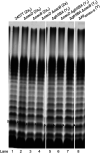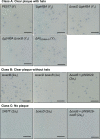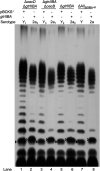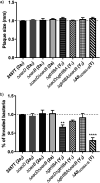Influence of Shigella flexneri 2a O Antigen Acetylation on Its Bacteriophage Sf6 Receptor Activity and Bacterial Interaction with Human Cells
- PMID: 32989087
- PMCID: PMC7685545
- DOI: 10.1128/JB.00363-20
Influence of Shigella flexneri 2a O Antigen Acetylation on Its Bacteriophage Sf6 Receptor Activity and Bacterial Interaction with Human Cells
Abstract
Shigella flexneri is a major causative agent of bacillary dysentery in developing countries, where serotype 2a2 is the prevalent strain. To date, approximately 30 serotypes have been identified for S. flexneri, and the major contribution to the emergence of new serotypes is chemical modifications of the lipopolysaccharide (LPS) component O antigen (Oag). Glucosylation, O-acetylation, and phosphoethanolamine (PEtN) modifications increase the Oag diversity, providing benefits to S. flexneri LPS Oag acts as a primary receptor for bacteriophage Sf6, which infects only a limited range of S. flexneri serotypes (Y and X). It uses its tailspike protein (Sf6TSP) to establish initial interaction with LPS Oags that it then hydrolyzes. Currently, there is a lack of comprehensive study on the parent and serotype variant strains from the same genetic background and an understanding of the importance of LPS Oag O-acetylations. Therefore, a set of isogenic strains (based on S. flexneri 2457T [2a2]) with deletions of different Oag modification genes (oacB, oacD, and gtrII) that resemble different naturally occurring serotype Y and 2a strains was created. The impacts of these Oag modifications on S. flexneri sensitivity to Sf6 and the pathogenesis-related properties were then compared. We found that Sf6TSP can hydrolyze serotype 2a LPS Oag, identified that 3/4-O-acetylation is essential for resistance of serotype 2a strains to Sf6, and showed that serotype 2a strains have better invasion ability. Lastly, we revealed two new serotype conversions for S. flexneri, thereby contributing to understanding the evolution of this important human pathogen.IMPORTANCE The emergence of antibiotic-resistant strains and lack of efficient vaccines have made Shigella a priority organism for the World Health Organization (1). Therefore, bacteriophage therapy has received increasing attention as an alternative therapeutic approach. LPS Oag is the most variable part of LPS due to chemical modifications and is the target of bacteriophage Sf6 (S. flexneri specific). We dissected the evolution of S. flexneri serotype Y to 2a2, which revealed a new role for a gene acquired during serotype conversion and furthermore identified new specific forms of LPS receptor for Sf6. Collectively, these results unfold the importance of the acquisition of those Oag modification genes and further our understanding of the relationship between Sf6 and S. flexneri.
Keywords: O antigen; O-acetylation; Sf6; Shigella flexneri; bacteriophages; glucosylation; lipopolysaccharide; serotypes.
Copyright © 2020 American Society for Microbiology.
Figures









Similar articles
-
Bacteriophage Sf6 host range mutant that infects Shigella flexneri serotype 2a2 strains.FEMS Microbiol Lett. 2022 Apr 1;369(1):fnac020. doi: 10.1093/femsle/fnac020. FEMS Microbiol Lett. 2022. PMID: 35218200 Free PMC article.
-
Serotype-conversion in Shigella flexneri: identification of a novel bacteriophage, Sf101, from a serotype 7a strain.BMC Genomics. 2014 Aug 30;15(1):742. doi: 10.1186/1471-2164-15-742. BMC Genomics. 2014. PMID: 25174528 Free PMC article.
-
Host Range Expansion of Shigella Phage Sf6 Evolves through Point Mutations in the Tailspike.J Virol. 2022 Aug 24;96(16):e0092922. doi: 10.1128/jvi.00929-22. Epub 2022 Jul 27. J Virol. 2022. PMID: 35894604 Free PMC article.
-
Serotype-converting bacteriophages and O-antigen modification in Shigella flexneri.Trends Microbiol. 2000 Jan;8(1):17-23. doi: 10.1016/s0966-842x(99)01646-7. Trends Microbiol. 2000. PMID: 10637639 Review.
-
O-antigen modifications providing antigenic diversity of Shigella flexneri and underlying genetic mechanisms.Biochemistry (Mosc). 2015 Jul;80(7):901-14. doi: 10.1134/S0006297915070093. Biochemistry (Mosc). 2015. PMID: 26542003 Review.
Cited by
-
A novel fold for acyltransferase-3 (AT3) proteins provides a framework for transmembrane acyl-group transfer.Elife. 2023 Jan 11;12:e81547. doi: 10.7554/eLife.81547. Elife. 2023. PMID: 36630168 Free PMC article.
-
Structural elucidation of the O-antigen polysaccharide from Escherichia coli O125ac and biosynthetic aspects thereof.Glycobiology. 2022 Nov 22;32(12):1089-1100. doi: 10.1093/glycob/cwac061. Glycobiology. 2022. PMID: 36087289 Free PMC article.
-
Moo19 and B2: Structures of Schitoviridae podophages with T = 9 geometry and tailspikes with esterase activity.Sci Adv. 2024 Dec 20;10(51):eadt0022. doi: 10.1126/sciadv.adt0022. Epub 2024 Dec 18. Sci Adv. 2024. PMID: 39693418 Free PMC article.
-
Biological foundations of successful bacteriophage therapy.EMBO Mol Med. 2022 Jul 7;14(7):e12435. doi: 10.15252/emmm.202012435. Epub 2022 May 27. EMBO Mol Med. 2022. PMID: 35620963 Free PMC article. Review.
-
Development of a visual Adhesion/Invasion Inhibition Assay to assess the functionality of Shigella-specific antibodies.Front Immunol. 2024 Apr 12;15:1374293. doi: 10.3389/fimmu.2024.1374293. eCollection 2024. Front Immunol. 2024. PMID: 38680489 Free PMC article.
References
-
- Tacconelli E, Carrara E, Savoldi A, Harbarth S, Mendelson M, Monnet DL, Pulcini C, Kahlmeter G, Kluytmans J, Carmeli Y, Ouellette M, Outterson K, Patel J, Cavaleri M, Cox EM, Houchens CR, Grayson ML, Hansen P, Singh N, Theuretzbacher U, Magrini N, WHO Pathogens Priority List Working Group. 2018. Discovery, research, and development of new antibiotics: the WHO priority list of antibiotic-resistant bacteria and tuberculosis. Lancet Infect Dis 18:318–327. doi:10.1016/S1473-3099(17)30753-3. - DOI - PubMed
-
- Khalil IA, Troeger C, Blacker BF, Rao PC, Brown A, Atherly DE, Brewer TG, Engmann CM, Houpt ER, Kang G, Kotloff KL, Levine MM, Luby SP, MacLennan CA, Pan WK, Pavlinac PB, Platts-Mills JA, Qadri F, Riddle MS, Ryan ET, Shoultz DA, Steele AD, Walson JL, Sanders JW, Mokdad AH, Murray CJL, Hay SI, Reiner RC Jr. 2018. Morbidity and mortality due to Shigella and enterotoxigenic Escherichia coli diarrhoea: the Global Burden of Disease Study 1990–2016. Lancet Infect Dis 18:1229–1240. doi:10.1016/S1473-3099(18)30475-4. - DOI - PMC - PubMed
Publication types
MeSH terms
Substances
LinkOut - more resources
Full Text Sources

